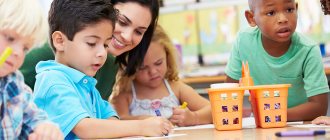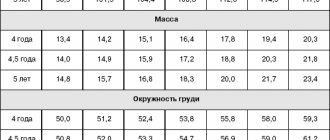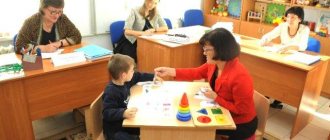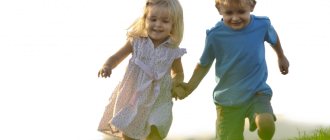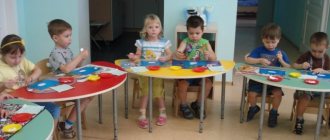"Childhood" program. Main directions of development of a preschool child
Natalia Strebkova
"Childhood" program. Main directions of development of a preschool child
" Program " Childhood "
.
The main directions of development of a preschool child »
Childhood is the summer wind ,
The sail of the sky and the crystal ringing of winter.
Childhood means children,
Childhood means us!
R. Rozhdestvensky
Preschool age is a bright, unique page in the life of every person. It is during this period that the process of socialization begins, the child’s with the leading spheres of existence is established: the world of people, nature, the objective world.
The goal of the program is to create for each child in kindergarten the opportunity to develop abilities , broad interaction with the world, active practice in various types of activities, and creative self-realization. The program is aimed at developing independence , cognitive and communicative activity, social confidence and value orientations that determine the child’s behavior, activities and attitude to the world .
Features of the content of the Childhood program
It is structured in accordance with the current interests of modern preschoolers and is aimed at their interaction with different spheres of culture: visual arts and music, children's literature and their native language, the natural world, the objective and social world. Such broad cultural and educational content becomes the basis for the development of cognitive and creative abilities, to satisfy the individual inclinations and interests of children at different stages of preschool childhood .
Each section of the program provides for the operation of a general mechanism:
There is a fascinating acquaintance of children with objects characteristic of a particular area of culture, the development of cognitive, practical, speech and creative skills in a variety of activities, allowing the child to show independence and creative activity to the best of his individual capabilities, conditions are created for the emotional acceptance by children of relevant moral and aesthetic values. values. As a result, the preschooler acquires the necessary personal sociocultural experience, which becomes the foundation for full development and readiness for school.
Motto of the Childhood Program
“Feel-Cognize-Create”
.
The line of feelings determines the direction of the preschooler’s emotional development in the program the child’s emotionally comfortable state , harmony of interaction with peers and adults, the objective and natural world. The emotional responsiveness of preschoolers is actively developing through exposure to art, music, literature, and folk culture.
Line of knowledge. The goal of the program is to promote the development of cognitive activity, curiosity, the desire for independent knowledge and reflection, the development of mental abilities and speech.
The line of independence and creativity of children. The goal of the program is to enrich the experience of independent activity, awaken children's creative activity, and stimulate their imagination.
Principles “ Childhood ” program
full-fledged life for a child at all stages of childhood
building educational activities based on the individual characteristics of each child .
assistance and cooperation between children and adults.
supporting children's initiative in various activities;
cooperation with family;
introducing children to sociocultural norms, traditions of the family, society and state;
formation of cognitive interests and cognitive actions of the child in various types of activities;
age adequacy of preschool education (compliance of conditions, requirements, methods with age and developmental );
taking into account the ethnocultural situation of children's development .
The life of a child of the 21st century has changed very much and is closely connected with the capabilities of his parents. He can master a mobile phone and computer, TV and tape recorder faster than an adult. He listens to and watches the same songs and TV shows with his parents; goes with his family to cafes and restaurants, goes abroad on vacation, travels; knowledgeable about car brands and advertising. He is interested in many things and talks about many things.
At the same time, the child is still focused on self-valued, childish activities . He loves to play, compose, fantasize, rejoice and reason.
All these new features of modern preschool childhood are reflected in the Program .
In the updated Program in accordance with the Federal State Educational Standard for preschool education:
The objectives, content and results of educational activities are determined in each age group and in each educational area:
Social and communicative development ,
Cognitive development ,
speech development ,
artistic and aesthetic development ,
Physical development ;
Variable forms, methods, methods and means of implementing the program ; features of educational activities of different types and cultural practices of children; features of the organization of pedagogical diagnostics and monitoring;
the features of interaction between the teaching staff and the families of students are characterized;
the content of teaching materials and training and education tools was determined; traditional events, holidays, events; features of the organization of the developing subject-spatial environment;
At the present stage, “ Childhood ” program
is a single
program and methodological complex , including:
“ Childhood ” program
for children from birth to 7 years;
methodological support for the implementation of the program in preschool educational organizations and in the family;
methodological support for the process of training a teacher ready to implement “ Childhood ” program
.
monitoring of child development and educational process in the context of the implementation of “ Childhood ” program
.
By the age of seven, with successful completion of the Program , the following level of development of the child’s qualities :
— Basic physical qualities
— Independently performs age-appropriate hygiene procedures,
— Interested in new, unknown things in the world around him
— Asks questions to adults, likes to experiment.
- Able to act independently
— Takes a lively, interested part in the educational process.
- Responds to the emotions of loved ones and friends.
- Empathizes with the characters of fairy tales, stories, stories.
— Reacts emotionally to works of fine art
— Adequately uses verbal and non-verbal means of communication, has dialogical speech and constructive ways of interacting with children and adults
- Able to change the style of communication with an adult or peer
— Behavior is primarily determined not by immediate desires and needs, but by demands from adults
— Able to plan his actions aimed at achieving a specific goal.
— Complies with the rules of behavior on the street in public places
- Can apply independently acquired knowledge and methods of activity to solve new problems (problems posed by both adults and himself;
- Able to propose his own idea and translate it into a drawing,
- Has ideas about himself, his own belonging and the belonging of other people to a certain gender;
- Able to work according to rules and patterns, listen to an adult and follow his instructions.
— The child has developed the skills and abilities necessary to carry out various types of children's activities .
- social feelings and moral experiences of pupils are formed;
— increased level of cognitive activity and curiosity;
— the ability to consciously use different methods and techniques of cognition, interest in experimentation, readiness for logical cognition has been formed;
- increased level of speech development ;
— the level of children’s creative activity and creative independence has been increased;
Long-term planning for the “Childhood” program for speech development.
Nadezhda Avdeeva
Long-term planning for the “Childhood” program for speech development.
Long-term planning for speech development
Time of implementation Topic and purpose of the lesson of the 1st week
"Colorful autumn"
Theme and objectives of the lesson of the 2nd week
"Garden. Vegetables"
Theme and objectives of the lesson of the 3rd week
"Garden. Fruits"
Theme and objectives of the lesson of the 4th week
“Trees and shrubs. Forest"
1 2 3 4 5 6
September Topic Lesson No. 1
“Memorizing I. Maznin’s poem “Autumn”
» Lesson No. 2
“Sound culture of speech : sounds [s] and [s]”
Lesson No. 3
“Compiling a descriptive story based on a set of objects and paintings”
Lesson No. 4
"Telling a picture
"Autumn forest"
Goals To consolidate children’s knowledge about the signs of autumn, to cultivate an emotional perception of the picture of autumn nature, to teach them to express their impressions in figurative words; develop the ability to expressively read a poem by heart, conveying thoughtfulness and sadness with intonation
(O. S. Ushakova p. 180)
Explain to children the articulation of the sound s, practice its correct, clear pronunciation (in words, phrasal speech )
.
(V.V. Gerbova p. 27)
1. Strengthen the ability to correctly name fruits and vegetables, describe their color, shape, etc.
2. Clarify ideas about the general concept of fruits and vegetables.
3. Continue teaching children to listen to the sound of words.
(O. S. Ushakova p. 70)
1. Draw children’s attention to paintings depicting autumn and spring.
2. Teach children to compare two seasons according to characteristic features.
3. Teach children to complete sentences read by the teacher.
(A.V. Adji p. 45)
The theme of the week is “The city we live in!”
“Wild animals and their young” “Domestic animals and their young” “Domestic birds”
October Topic Lesson No. 5
“Memorizing the poem by G. Novitskaya “Silence”
»» Lesson No. 6
“Sound culture of speech : sounds [з] and [зь]”
» Lesson No. 7
“Compiling a story based on the painting “Cat with kittens”
» Lesson No. 8
"Telling a picture
"Chickens"
»
Goals: Continue to teach children to emotionally perceive the figurative basis of poetic works; develop creative imagination and expressive speech . (O. S. Ushakova p. 147)
Exercise children in pronunciation of the isolated sound z (in syllables, words)
; learn to pronounce the sound z firmly and softly; distinguish words with the sound з, з.
(V.V. Gerbova p. 31)
1. Lead children to compose a short coherent story, as well as a short story based on personal experience.
2. Learn to correctly correlate the names of animals and their cubs, intensify the use of verbs in speech .
(O. S. Ushakova p. 26)
1. Teach children to write a short descriptive story based on the picture.
2. Learn to compare a rooster and a hen, a hen and chickens (by color, size, habits)
.
3. Strengthen the ability to independently select similar and dissimilar sounding words.
(O. S. Ushakova p. 78)
Time of implementation Topic and purpose of the lesson of the 1st week
"Apartment. Furniture"
Theme and objectives of the lesson of the 2nd week
"Kitchen. Dishes"
Theme and objectives of the lesson of the 3rd week
"Household and electrical appliances"
Theme and objectives of the lesson of the 4th week
"Cloth. Shoes. Hats"
1 2 3 4 5 6
November Topic Lesson No. 10
“Memorizing the RNS “Shadow-shadow-shadow”
» Lesson No. 11
“Sound culture of speech : sound [ts]”
Lesson No. 12
Storytelling from a picture
"Mother is washing the dishes"
Lesson No. 13
"Description of clothing items"
Goals To help children remember and read the song expressively.
Develop creative imagination. Foster a love of folk art.
(V.V. Gerbova p. 32)
Exercise children in the pronunciation of the sound ts (isolated, in syllables, in words)
.
Improve intonation expressiveness of speech .
Learn to distinguish words starting with the sound ts, focusing on the meaning of the word, and not its meaning. (V.V. Gerbova p. 35)
1. Teach children to compose a simple story using the teacher’s questions.
2. Strengthen the ability to form names for utensils. Please note that they are all formed in the same way.
3. To consolidate children’s knowledge that sounds in a word are pronounced in a certain sequence.
(O. S. Ushakova p. 65)
(winter) objects
clothes.
2. Learn to correctly name objects autumn (winter)
clothes, know their purpose. Secure the general word clothing.
3. Learn to use complex sentences in speech , to coordinate adjectives and nouns.
(O. S. Ushakova p. 48)
Theme of the week : “Winter in nature”
“Transport” “Toys. Games Musical Instruments” “The New Year holiday is in a hurry to visit us!”
December Topic Lesson No. 14
“Memorizing the poem by I Surikov “Winter”
»» Lesson No. 15
“Sound culture of speech : sounds [sh]”
Lesson No. 16
“Compiling a story based on a series of plot paintings “My Doll”
» Lesson No. 17
"Telling a picture
"Winter forest"
»
Goals To teach children to expressively read a poem by heart, conveying intonation an admiration of winter nature; develop the ability to feel , understand and reproduce the figurative language of a poem; learn to find a landscape painting based on a figurative description and justify your choice.
(O. S. Ushakova p. 184)
Show children the articulation of the sound sh, teach them to clearly pronounce the sound (in isolation, in syllables, in words)
; distinguish words with the sound sh.
(V.V. Gerbova p. 45)
1. Teach children to carefully examine the picture, notice changes in the mood in the picture, notice features, find similarities and differences.
2. Teach simple comparisons with various objects.
3. Pronouncing pure sayings with the sound sh.
(A.V. Adji p. 78)
1. Teach children to correlate the winter landscape seen in the picture with listening to a literary work.
2. Learn to perform creative tasks, develop creative imagination and fantasy.
3. Mini-story “What would you like to receive from Santa Claus...”
Teach children to construct phrases based on speech patterns.
(A.V. Adji p. 74)
Time of implementation Topic and purpose of the lesson of the 1st week
"Christmas. Carols. Winter fun"
Theme and objectives of the lesson of the 2nd week
“Russian customs, traditions, folk holidays”
Theme and objectives of the lesson of the 3rd week
"In the world of Russian literature"
Theme and objectives of the lesson of the 4th week
"Health and Me"
1 2 3 4 5 6
January Topic Lesson No. 18
“Memorizing the poem by A. Barto “I know what I need to come up with”
» Lesson No. 19
“Sound culture of speech : sound [zh]”
Lesson No. 20
Description of toys
"Fairy-tale heroes"
Lesson No. 21
Storytelling from a picture
"Winter Fun"
Goals To teach children to expressively read a poem by heart, conveying intonation an admiration of winter nature; develop the ability to feel , understand and reproduce the figurative language of a poem.
(V.V. Gerbova p. 51)
Exercise children in pronunciation of the sound zh (isolated, in syllables, in words. Teach them to distinguish words starting with the sound zh.
(V.V. Gerbova p. 35)
1. Teach children to write a short descriptive story about a toy
2. Learn to focus on the endings of words when agreeing adjectives with nouns in gender, and with augmentative suffixes.
(O. S. Ushakova p. 43)
1. Exercise children in dialogical speech . Asking questions about a fragment of a picture. Compiling miniature stories of 3-4 sentences based on children's ideas. To cultivate a love for our native nature, for the Russian winter.
(A.V. Adji p. 71)
Topic of the week : “Me and My Family.
Me and My Friends” “Our Motherland is Russia!” “Defender of the Fatherland Day” “Early spring.
First flowers" February Topic Lesson No. 22
“Memorizing the poem by Yu. Kushak “Little Deer”
»» Lesson No. 23
“Sound culture of speech : sounds [h]”
Lesson No. 24
Storytelling based on the painting “Family”
» Lesson No. 25
Compiling a descriptive story based on a painting of spring landscapes.
Goals To teach children to expressively read a poem by heart, to understand and reproduce the figurative language of the poem. Cultivate a love for animals.
(V.V. Gerbova p. 66)
Show children the articulation of the sound h, teach them to clearly pronounce the sound (in isolation, in syllables, in words)
;
distinguish words with the sound h. Develop children's phonemic hearing.
(V.V. Gerbova p. 53)
1. First ask the children to bring photographs of their family, their relatives. Teach children, looking at photographs, to name family ties (grandson, granddaughter, daughter, son, nephew, etc.)
2. Talk to the children about who is in charge in their family, about whom you can say “head of the family”
and why.
(A.V. Adji p. 125)
1. Teach children to write a descriptive story in comparison: “Early Spring”, “Late Spring”
.
2. Learn to find features in two landscapes, notice, name, compare.
3. Remember the natural phenomena characteristic of spring.
(A.V. Adji p. 111)
Time of implementation Topic and purpose of the lesson of the 1st week
"Our Mothers"
Theme and objectives of the lesson of the 2nd week
“All professions are needed, all professions are important”
Theme and objectives of the lesson of the 3rd week
"Food"
Theme and objectives of the lesson of the 4th week
"Houseplants"
1 2 3 4 5 6
March Topic Lesson No. 26
“Memorizing the poem by Y. Akim “Snowdrop”
» Lesson No. 27
“Sound culture of speech : sound [sch-h]”
Lesson No. 28
Narration based on a set of objects
"Food and utensils"
Lesson No. 29
Narrating paintings and illustrations of “House Plants”
Goals To teach children to expressively read a poem by heart, conveying intonation an admiration of spring nature; develop the ability to feel , understand and reproduce the figurative language of a poem.
(V.V. Gerbova pp. 58-59)
Exercise children in the correct pronunciation of the sound u and differentiation of sounds u-ch.
(V.V. Gerbova p. 60)
1. Train children in writing stories about objects and actions with them.
2. Train in the formation of words - names of products, dishes and diminutive proper names.
3. Learn to correctly pronounce the sound h, clearly name words with this sound.
(O. S. Ushakova p. 61)
Exercise children in dialogical speech . Asking questions about a fragment of a picture. Compiling miniature stories of 3-4 sentences based on children’s ideas.
(O. S. Ushakova p. 40)
Theme of the week : “Water.
Inhabitants of the Water" "Cosmonautics Day" "Insects" "Easter Week"
April Topic Lesson No. 30
“Memorizing the poem by S. Marshak “About Spring”
»» Lesson No. 31
“Sound culture of speech : sounds [l] and [l]”
Lesson No. 32
Description of toys and paintings “Insects”
Lesson No. 33
Looking at paintings depicting summer and winter
Goals To develop in children the ability to feel the melodiousness and rhythm of the language of a poem, to teach them to convey their attitude to its content; develop skills in expressive performance of poetry.
(O. S. Ushakova p. 190)
Show children the articulation of the sound l, teach them to clearly pronounce the sound
(in isolation, in syllables, in words)
. Improve phonemic perception - learn to identify words with the sounds l, l.
(V.V. Gerbova p. 63)
1. Learn to describe a toy, name its characteristic features and actions; lead to writing a short story.
2. Enrich the dictionary with the correct names of surrounding objects (toys, their properties and actions.
(O. S. Ushakova p. 30)
1. Clarify children’s understanding of the changing seasons.
2. Compiling stories – miniatures of 3-4 sentences based on children’s ideas.
(A.V. Adji p. 39)
Time of implementation Topic and purpose of the lesson of the 1st week
"Our Mothers"
Theme and objectives of the lesson of the 2nd week
“All professions are needed, all professions are important”
Theme and objectives of the lesson of the 3rd week
"Food"
Theme and objectives of the lesson of the 4th week
"Houseplants"
1 2 3 4 5 6
May Topic Lesson No. 35
“Memorizing the poem by T. Belozerov “Victory Holiday”
» Lesson No. 36
“Sound culture of speech : sound [р] and [рь]”
Lesson No. 37
Consolidation of general concepts Lesson No. 38
Literary kaleidoscope
Objectives: Find out what children know about the great holiday. To develop in children the ability to feel the melodiousness and rhythm of the language of a poem, to teach them to convey their attitude to its content; develop skills in expressive performance of poetry.
(V.V. Gerbova p. 68)
Show children the articulation of the sound r, teach them to clearly pronounce the sound (in isolation, in syllables, in words)
;
distinguish words with the sounds r, r. Develop phonemic awareness .
(V.V. Gerbova p. 69)
1. Continue teaching children to describe objects, choosing words that are necessary for their meaning.
2. Strengthen understanding of general concepts: vegetables, clothing, furniture.
3. Teach children to clearly and correctly pronounce the sound r, r. Choose words with this sound.
(O. S. Ushakova p. 80)
Find out if children have favorite poems, fairy tales, stories; Do they know riddles and counting rhymes?
(V.V. Gerbova p. 71)
Used Books:
1. O. S. Ushakova “
Speech development ” (children 4-5 years old)
-M.
publishing house 2010
2. V.V. Gerbova “Classes on speech development in the middle group of kindergarten ” - M. Publishing house "Mosaic - Synthesis"
2010
3. A. V. Adzhi “Notes of integrated classes in the middle group of kindergarten ” - Voronezh: TC “Teacher”
2005
Theme and purpose of the lesson of the 5th week
"Migratory and sedentary birds"
Theme and purpose of the lesson of the 5th week
"Rescue Services 01,02,03"
Lesson No. 9 “Familiarization with small folklore forms”
. Lesson No. 34
"A Lesson in Politeness"
.
Learn to solve riddles based on description and comparison; form ideas about the riddle genre; introduce them to tongue twisters, their meaning, teach them to pronounce them clearly, and come up with short stories based on their plot.
(O. S. Ushakova p. 149)
1. Tell the children about how it is customary to greet guests, how and what is best to show the guest so that he does not get bored.
2. Exercise children in dialogical speech .
(V.V. Gerbova p. 56)

